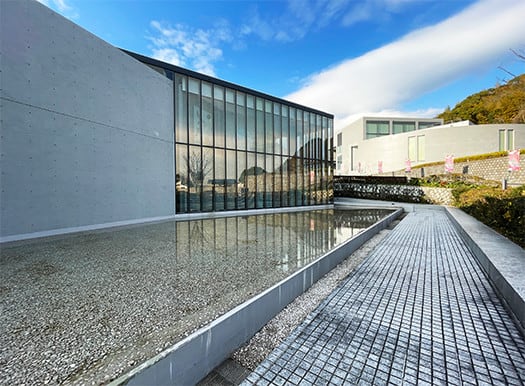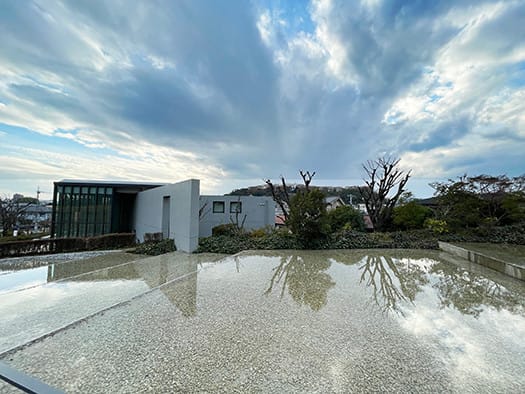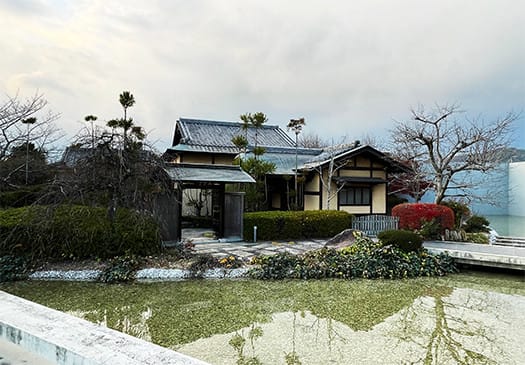

さて昨日は姫路に立ち寄ったということで敬意を表して「姫路城」天守建築を主題に据えて書きましたが、建築行脚としては本当はこちらの安藤忠雄建築がメイン。
北海道で、高断熱高気密の住宅運動の初期からの流れに随伴してきた経験から「居住環境性」の視点から建築をみることが習慣化してきています。そのことは当然のこととして前提にしているのですが、一方でいわば「視覚的環境性」という意味合いでの建築というものもごく自然に「数寄」であることは論を待たない。
個人的体験として安藤建築の宿泊施設などでの印象、体感が積み重なってくると、どうも「音楽性」的な受け止め方が掘り起こされてくる思いがします。環境音楽を聴きながら建築をカラダで受け止める、あるいは建築自体に音楽性を感じる、というような部分でしょうか。あるホテル建築で、実際にバックグラウンド音楽が低く流れているなかで、安藤建築のホテル建築と同時に周辺環境建築をあるく体験を持ったのですが、その音楽旋律との調和感が非常に強く残っていて、その音楽楽曲名を調べてその旋律を大好きになった経験がある。自分で振り返って考えて見ると、音楽と建築の親和性ということへの気付きの端緒のようだった。
北海道の高断熱高気密の住宅建築でも、そのような音楽性という気付きが大きな刺激力を持っているのかも知れないと思わされたのです。そして多くのそういう角度から事例を再発見する経験を持ってきていると思っています。ただし、この安藤建築のように自覚的ではなかったのではないかなぁとあらためて気付かされている。
今回見たこの姫路文学館も、期待以上にそういう体感を持った。
昨日のブログの姫路城天守の写真も実は、この姫路文学館からの眺望角度。この遠景としてのアングル姫路城も、たぶん相当大きな「建築要素」として建築家は計算していたのだろうという体験だったのですが、さらに「オマケ」が付いていた(笑)。

こちらは、姫路文学館の敷地内の主旋律のような人工の鏡の水面越しに、まるで「対話」するかのように配置されている「望景亭」。おお、この手があったのかと驚かされた。
そうなんです、相変わらず事前調査もなく風来坊的に建築体験するので、奥の院的に存在したこの「望景亭」のことは来て見てはじめてその存在を知った。
この建物は姫路市の実業家・濱本氏が別邸として、大正5年から昭和4年までの15年ほどの歳月を掛けた庭園と調和する名建築。
両方を体感してみて、その建築的音楽性というシナジー効果がくっきりと浮かび上がってきた次第なのです。しかも去り際には強烈な雷雨に打たれて、冬用のダウンコートが身を守ってくれたけれど、一種爽快感もあった。さてもなかなかにオモシロい。
English version⬇
The musicality of Tadao Ando's Himeji Literature Center and the traditional architecture of Mokei-tei
There must be various visual and experiential “phrases” in the “musicality” of architecture. Rhythm, melody, and harmony. It develops monotonically. ・・・・.
Yesterday, I wrote about the Himeji Castle keep as a tribute to my stopover in Himeji, but the main focus of my architectural excursion is Tadao Ando's architecture.
Having accompanied the early movement for highly insulated and airtight housing in Hokkaido, it has become a habit for me to look at architecture from the viewpoint of “habitability. I assume this as a matter of course, but on the other hand, it is indisputable that architecture in the sense of “visual environmentality,” so to speak, is also very naturally “sukiya.
As my personal experience with Ando's architectural accommodations and impressions and experiences accumulate, I feel that I am beginning to discover a “musicality” in the way I perceive the architecture. I guess it is like listening to environmental music and perceiving the architecture with the body, or feeling the musicality of the architecture itself. I had the experience of walking around a certain hotel building with background music playing low in the background, and at the same time walking around the surrounding environmental architecture, and the sense of harmony with the musical melody remained so strong that I looked up the name of the musical piece and fell in love with the melody. Looking back and thinking about it myself, it seemed to be the beginning of my realization of the affinity between music and architecture.
It made me think that such an awareness of musicality might have a great stimulating power in the highly insulated and airtight residential architecture of Hokkaido. And I believe I have the experience of rediscovering many examples from such angles. However, I am reminded again that I may not have been as aware as I was of this Ando architecture.
This Himeji Museum of Literature that I saw this time also had such an experience beyond my expectations.
The photo of Himeji Castle Keep in yesterday's blog was actually taken from the angle of the view from the Himeji Museum of Literature. The angle of Himeji Castle as a distant view was an experience that the architects probably calculated as a significant “architectural element,” but there was an additional “bonus” attached to it (laugh).
This is the “Bokkeitei,” which is placed as if in “dialogue” with the main melody of the grounds of the Himeji Museum of Literature, over the surface of the artificial mirror like water. Oh, I was surprised to see this move.
Yes, as usual, I had no prior research before visiting the site, so I did not know about this “Bokkeitei” until after I arrived at the site.
This building was the villa of Mr. Hamamoto, a businessman in Himeji City, and was built over a period of about 15 years from 1916 to 1929, and is a masterpiece in harmony with the garden.
After experiencing both buildings, the synergy of their architectural musicality came to the fore. Moreover, as I was leaving, I was hit by a strong thunderstorm, and although my winter down coat protected me, I felt a kind of exhilaration. It was quite interesting.




























※コメント投稿者のブログIDはブログ作成者のみに通知されます